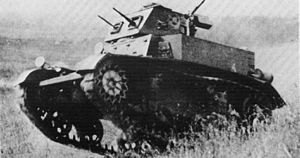M1 Combat Car
| M1 Combat Car | |
|---|---|

M1 Combat Car in the field |
|
| General properties | |
| crew | 4th |
| length | 4.14 m |
| width | 2.39 m |
| height | 2.36 m |
| Dimensions | 8.7 t |
| Armor and armament | |
| Armor | 6-16 mm |
| Main armament | 1 machine gun 12.7 mm, |
| Secondary armament | 2 machine guns Browning M1919 7.62 mm |
| agility | |
| drive | Continental Star 8 W670 air-cooled 7-cylinder star gasoline engine 250 PS (184 kW) (281 SAE-HP) at 2400 rpm |
| Top speed | 72 km / h |
| Power / weight | [21.1 kW / t] |
| Range | 240 km |
The M1 Combat Car ( German Kampfwagen ) was a light tank of the US Army in the period before and during the Second World War .
history
According to the National Defense Act of 1920, only infantry units were allowed to use tanks in the US Army. In order to meet General McArthur's demands in the 1930s for the motorized cavalry to be equipped with combat vehicles, the name Combat Car was created, thus circumventing the New Deal .
The prototype with the designation T1 was equipped with a 12.7 mm and a 7.62 mm machine gun in a rotating turret. Four of these vehicles were manufactured and, after testing, used up as targets on the shooting range by 1936. In 1931, the Rock Island Arsenal made a prototype called the T2 , but nothing is known about this other than that the vehicle could move with and without tracks. T3 was the name of a proposal for the further development of the T2 , the chassis of which was equipped with the Vickers leaf spring system, and which was not implemented. Then the parallel development of the T4 and T5 vehicles began , whereby the T4 vehicle was based on the model of the wheel / track tank T3 M1931 by John Walter Christie and which would have been preferred by the troops because of its more stable weapon platform and better trench crossing ability. On November 14, 1934, however, the T5 prototype (which had already been favored by the US Department of War) was sent for an endurance test that lasted three days and led over 1,450 km from the Rock Island Arsenal to Washington . An average speed of 48 km / h was achieved without any problems.
Then, the US War Department ordered the variant T5 , which was equipped with the drive of a light tractor from the year 1933rd This drive was equipped with the vertical coil springs and rollers suspended in pairs in a cradle, as would be characteristic of American armored vehicles during the Second World War.
In January 1938, the series production of the now called M1 Combat Car started . In the same year the first improvements (including the gearbox) began, which earned the tank the new designation M1E1 . In December 1938 the 7th Cavalry Brigade had a total of 112 vehicles of both types. After a further 292 vehicles were ordered as part of the precautionary mobilization in 1940, the camouflage designation could also be omitted through the creation of a separate tank force. The designation that was used from then on was M1A1 or M1A2 (Light Tank). They remained in service as training vehicles until 1942, with some of them already being cannibalized for spare parts. Then the last 147 vehicles were scrapped.
Further technical data
- Ground pressure : 0.58 kg / cm 2
- Wading ability: 1.32 m
- Gradeability: 62%
literature
- Tanks and other combat vehicles from 1916 to the present day . Book and Time, Cologne 1977.